Top 7 Golden Rules of Customer Service [2025]
Excellent customer service means actively listening, offering clear solutions and going the extra mile. Empathy and honesty are the top rules of customer service. Respect and appreciation go a long way.

Excellent customer service means actively listening, offering clear solutions and going the extra mile. Empathy and honesty are the top rules of customer service. Respect and appreciation go a long way.

Ever had a bad experience with customer service that left a feeling of dissatisfaction? Customer service plays a crucial role in shaping the reputation and success of a business. Knowing and following the essential rules of customer service. It can make a significant difference in customer satisfaction and loyalty.
Providing excellent customer service is no longer just a nice-to-have; it’s a must. There’s an 80 percent increase in revenue for companies that focus on CX. Customers now have high expectations. They can easily take their business elsewhere if their needs are not met. Understanding and abiding by the principles of customer service is important.
Customer service is more than just resolving complaints or answering inquiries. It is also about creating positive interactions and building trust with customers. Let’s explore the essential rules that every business should adhere to for delivering exceptional customer service.
Rules of customer service can be defined as the fundamental principles that guide how businesses interact with their customers throughout every touchpoint of their journey. These serve as a roadmap for creating positive experiences that turn first-time buyers into loyal advocates. Think of them as the DNA of great customer relationships – they define how your team responds to questions and handles problems while building trust that lasts beyond a single transaction.
Customer service rules work by creating consistent standards that every team member follows when helping customers. They provide clear guidelines for handling different situations from simple questions to complex complaints. When everyone follows the same approach customers know what to expect and feel confident they’ll receive quality help every time they reach out.
Key objectives:
Let’s explore the various benefits that strong customer service rules can bring to your business, helping you achieve greater success and satisfaction for both your clients and your team.
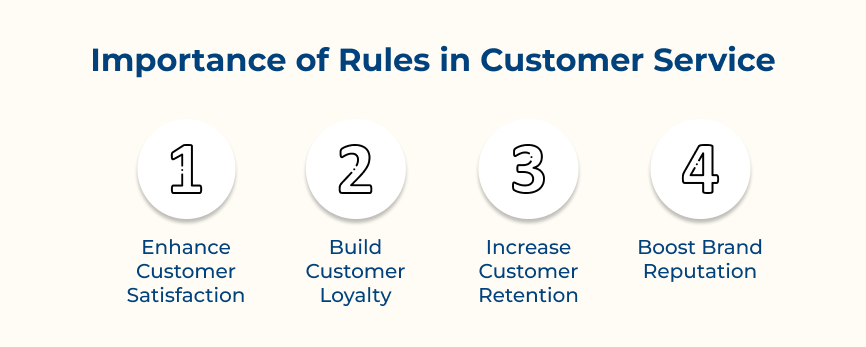
Businesses can ensure that customers are satisfied with their experience by following the customer service golden rules. It includes listening to their needs, addressing their concerns promptly and providing solutions to their problems. When customers are happy with the service, they are more likely to become repeat customers and recommend it to others.
Providing excellent customer service can help build customer loyalty. Customers are more likely to continue doing business with a company that values their needs. When businesses follow the golden rules of customer service, they can create strong relationships. It can also help them earn their trust and loyalty over time.
Happy customers are more likely to stick around, which can lead to increased customer retention rates. Customer retention rates increase by 5% for every 1% increase in customer satisfaction. Following the customer service golden rules can ensure that customers have a positive experience every time they interact with the business. It makes them more likely to return in the future.
Customer service plays a significant role in shaping the brand’s reputation. Consistently providing exceptional service can establish a positive reputation. It can also help businesses differentiate themselves from competitors. A strong brand reputation can attract new customers and help the business stand out.
Here are the top golden rules that form the foundation of outstanding customer service, ensuring that you not only meet but exceed customer expectations every single time.
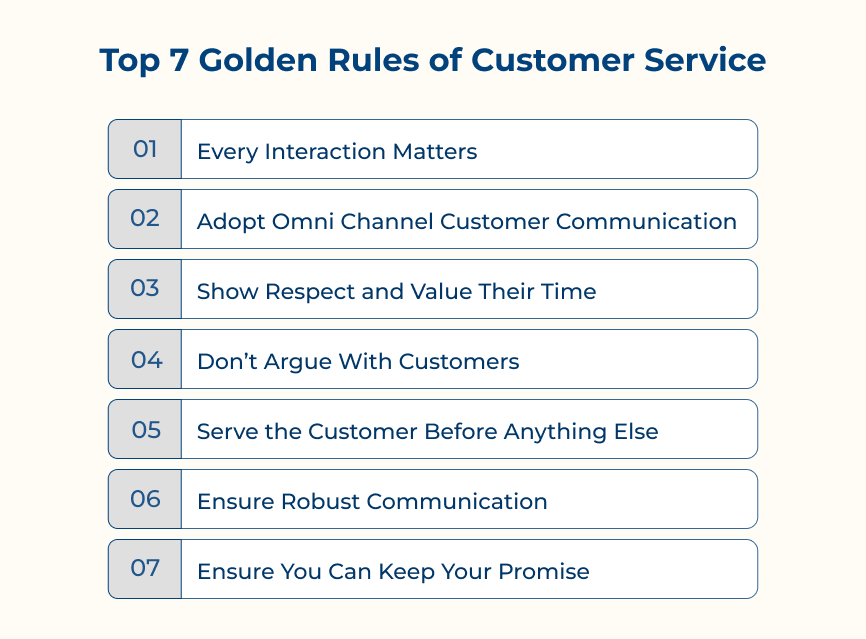
The golden rule of customer service, “Every Interaction Matters,” emphasizes the importance of treating every customer interaction with respect, empathy and professionalism. The rule is considered golden because it lays the foundation for building strong customer relationships. It also improves customer satisfaction and enhances brand loyalty.
The rule is evident when a representative exceeds expectations to solve a customer’s issue, dedicating extra time or resources. Let’s assume that a customer service agent remains on the call with a frustrated customer until resolving their issue, without rushing them. It demonstrates dedication to making every interaction count.
Best practices:
Adopting Omni Channel Customer Communication is considered the Top Customer Service Golden Rule. The rule emphasizes the importance of providing consistent and seamless communication across all channels. It includes social media, email, phone and in-person interactions. Brands with top omnichannel customer engagement see a 9.5% yearly increase in annual revenue.
One reason why the rule is considered a golden rule is because it allows businesses to meet customers where they are. Let’s consider that a customer might start their inquiry on a company’s website. They can continue the conversation over email and then finalize their purchase on a mobile app. The customer feels valued and appreciated by having a consistent experience across all channels.
Best practices:
“Show Respect and Value Their Time” is known as one of the top customer service golden rules. It acknowledges the importance of excellent customer service. Showing respect and valuing a customer’s time can build strong relationships with their customers.
Let’s assume that a customer calls a company with a question about their product. Instead of being put on hold for an extended period, the representative addresses their concern promptly. It not only shows respect for the customer’s time but also leaves a positive impression.
Best practices:
“Don’t Argue With Customers” is a top customer service golden rule. Maintaining a positive and professional attitude with customers is crucial, even in challenging situations. The rule is considered golden because it focuses on putting the customer first. It ensures their satisfaction, which is crucial for building strong relationships and loyalty.
A real-life example of the rule in action is when a customer complains about a product or service. Instead of arguing with the customer, a good representative will listen attentively. They will also empathize with the customer’s concerns and work towards finding a solution.
Best practices:
“Serve the Customer Before Anything Else” is a fundamental principle in the realm of customer service. The golden rule emphasizes the importance of prioritizing the needs and satisfaction of the customer above all else.
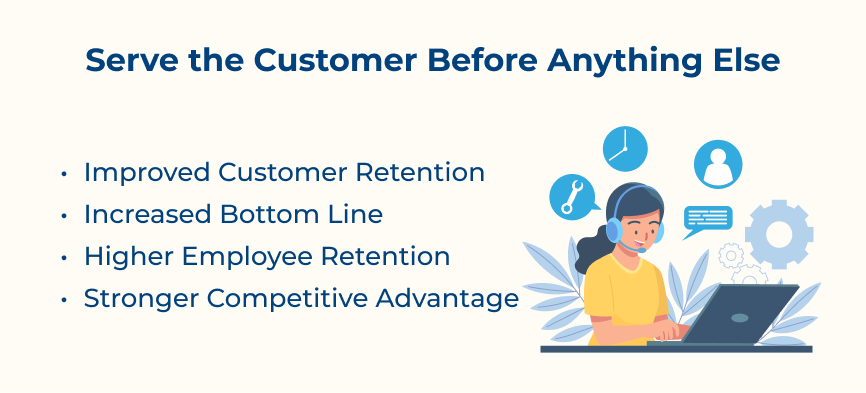
The rule is considered golden because satisfied customers are more likely to become repeat customers and advocates for the business. Businesses can build strong relationships, increase loyalty and drive growth by putting the customer first.
A real-life example of the rule in action is the renowned online retailer, Amazon. Amazon’s relentless focus on customer satisfaction has helped it become one of the most successful companies. They are known for their fast delivery, easy returns process and excellent customer service.
Best practices:
“Ensure Robust Communication” is often referred to as the top golden rule of customer service. The rule emphasizes the importance of clear and effective communication with customers. It ensures their needs are met and expectations are managed. Maintaining open lines of communication can build trust with their customers and enhance their overall experience.
Robust communication is crucial. It helps to prevent misunderstandings, address issues promptly and build strong relationships with customers. Let’s consider a customer who receives regular updates about the status of their order is more likely to feel valued and satisfied.
Best practices:
“Ensure You Can Keep Your Promise” is a top customer service golden rule. It emphasizes the importance of delivering on the commitments to customers. Keeping promises builds trust and credibility with customers. It leads to increased customer satisfaction and loyalty.
Companies need to prioritize customer service to stay ahead of the competition. Businesses can differentiate themselves by adhering to the rule and create a positive reputation. A real-life example of the importance of keeping promises in customer service can be seen in the hospitality industry. Hotels excelling in customer service through top-notch amenities receive rave reviews and repeat business from satisfied guests.
Best practices:
Below are the key steps to constructing effective customer service standards that can put your business on the path to excellence.
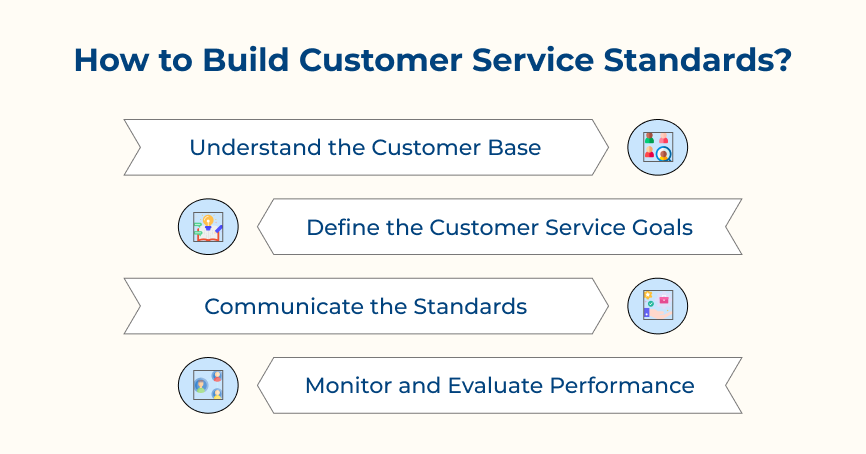
The first step in building effective customer service standards is understanding the customer base. Understanding customers involves knowing who they are, what they value and how they want to be treated. Conducting customer surveys and analyzing customer data can help businesses gain a better understanding of the target audience.
Once businesses have a clear understanding of the customer base, it’s important to define the customer service goals. What does the business want to achieve with the customer service interactions? Does it aim for quick service or a personalized, exceptional experience? Clearly defining the goals will help guide the development of the customer service standards.
Once businesses have established customer service standards, it’s important to communicate them clearly to the team. It involves training on standards, creating resources and reinforcing exceptional customer service regularly. Make sure the team understands what is expected of them and is equipped to meet those expectations.
Building customer service standards is an ongoing process. It’s important to regularly monitor and evaluate the team’s performance. It helps to ensure that they are meeting the established standards. Assess team performance in delivering customer service goals by using feedback, metrics and mystery shopping techniques. Make adjustments as needed to continuously improve the customer experience.
Check out the common challenges that arise from rigid service rules to understand how you can strike the right balance between structure and adaptability.
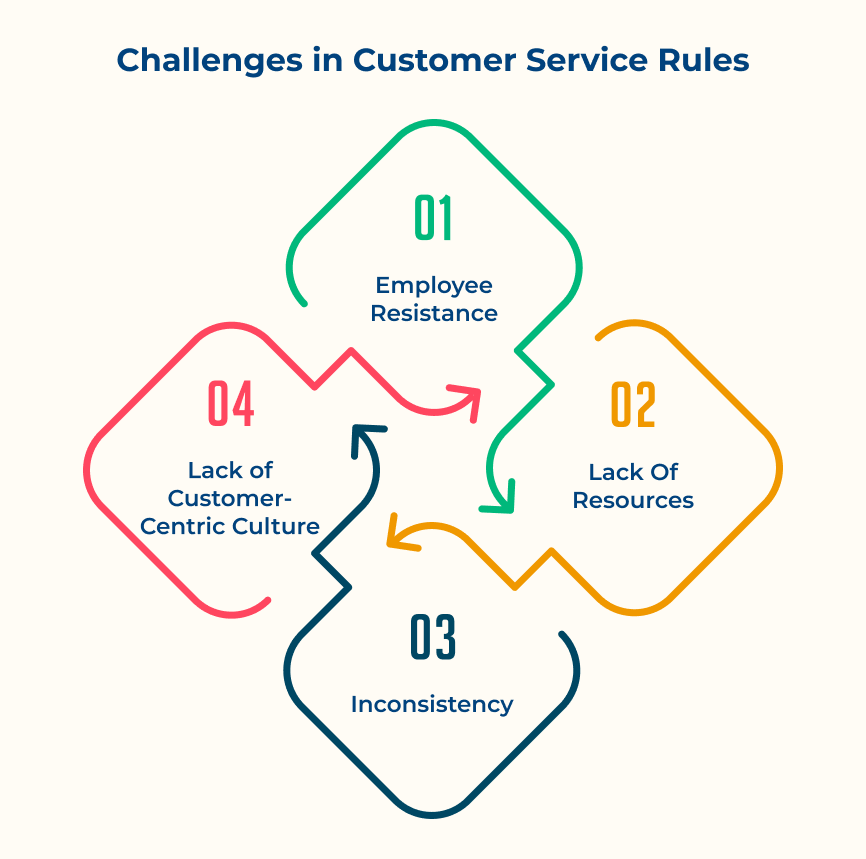
One of the biggest challenges in implementing customer service rules is overcoming employee resistance. Employees may be resistant to change or hesitant to adopt new policies and procedures. Companies should communicate the reasons for implementing rules of customer service. They should also make employees aware of how it will benefit both the business and the employees.
Another challenge in implementing customer service rules is the lack of resources, such as time, budget and personnel. Companies may struggle to allocate the resources to train employees, update technology and monitor customer service performance. Companies should prioritize customer service as a key aspect of their business strategy. They should also allocate sufficient resources to support its implementation.
Maintaining consistency in customer service delivery across all channels can be a challenge for businesses, especially as they expand. Companies should develop clear and comprehensive customer service guidelines to ensure consistency in service delivery. Regular monitoring of customer service performance, as well as feedback from customers, can help identify areas that need improvement. It enables companies to make necessary adjustments.
Implementing customer service rules requires a customer-centric culture that prioritizes the needs and satisfaction of customers. Without a strong customer-focused culture, companies may struggle to consistently deliver exceptional customer service. Companies should instill a customer-centric mindset throughout the organization by emphasizing the importance of customer service. They can also reward employees for exceptional performance and involve employees in decision-making processes.
Mastering the art of customer service requires understanding and implementing the rules of customer service. Focusing on building strong relationships, listening to customers and resolving issues promptly can create a loyal customer base.
Every interaction with a customer is an opportunity to exceed expectations and leave a lasting impression. Businesses can differentiate themselves by following the rules and continuously striving to improve. Embrace the rules and watch the business thrive.
Following the rules of customer service, such as listening to feedback and responding promptly can help to grow the business by creating loyal customers. Providing excellent customer service builds trust and credibility. It leads to increased customer satisfaction and business growth.
The rule of 5 in customer service is a guideline. It suggests a customer will share a positive experience with five people, but a negative experience with 15 people. Emphasizing exceptional service boosts positive word-of-mouth recommendations. Following the rule can enhance their reputation and build customer loyalty.
Businesses can measure the effectiveness of their customer service rules by analyzing feedback and monitoring KPIs. It can involve customer satisfaction scores and customer retention rates. They can conduct regular reviews of its customer service processes. Tracking the metrics can identify areas for improvement. It can also help them make adjustments to their rules as needed.
Businesses can train their employees to follow customer service rules by providing clear guidelines, offering regular training and providing feedback. It can help employees to improve their service skills. Businesses should also demonstrate exemplary customer service through their actions to set a positive example.
The best communication channels for customer service include phone, email, live chat and social media. It’s important to offer multiple channels to accommodate different customer preferences and ensure timely responses to inquiries.

Market better, sell faster and support smarter with Veemo’s Conversation Customer Engagement suite of products.
Unify all your customer data in one platform to deliver contextual responses. Get a 360 degree view of the customer lifecycle without switching tools.
Connect with the tools you love to reduce manual activities and sync your business workflows for a seamless experience.
 https://veemo.io/wp-content/uploads/2024/12/customer-service-response-time.png
1256
2400
Webvision Solution
https://veemo.io/wp-content/uploads/2024/11/veemo.svg
Webvision Solution2025-10-17 10:51:142025-10-17 10:51:149 Effective Tips to Reduce Customer Service Response Time
https://veemo.io/wp-content/uploads/2024/12/customer-service-response-time.png
1256
2400
Webvision Solution
https://veemo.io/wp-content/uploads/2024/11/veemo.svg
Webvision Solution2025-10-17 10:51:142025-10-17 10:51:149 Effective Tips to Reduce Customer Service Response Time https://veemo.io/wp-content/uploads/2024/06/Customer-Communication-Best-Practices1.png
628
1200
Vikas Sachan
https://veemo.io/wp-content/uploads/2024/11/veemo.svg
Vikas Sachan2024-11-05 06:43:042024-11-05 06:43:04Top 15 Customer Communication Best Practices for Businesses
https://veemo.io/wp-content/uploads/2024/06/Customer-Communication-Best-Practices1.png
628
1200
Vikas Sachan
https://veemo.io/wp-content/uploads/2024/11/veemo.svg
Vikas Sachan2024-11-05 06:43:042024-11-05 06:43:04Top 15 Customer Communication Best Practices for Businesses https://veemo.io/wp-content/uploads/2024/02/Live-Chat-for-Sales.png
628
1200
teamwebvisionsolution@gmail.com
https://veemo.io/wp-content/uploads/2024/11/veemo.svg
teamwebvisionsolution@gmail.com2024-10-21 11:31:222025-08-06 10:22:06How to Use Live Chat for Sales? 7 Proven Ways to Grow Revenue
https://veemo.io/wp-content/uploads/2024/02/Live-Chat-for-Sales.png
628
1200
teamwebvisionsolution@gmail.com
https://veemo.io/wp-content/uploads/2024/11/veemo.svg
teamwebvisionsolution@gmail.com2024-10-21 11:31:222025-08-06 10:22:06How to Use Live Chat for Sales? 7 Proven Ways to Grow RevenueGrow Customer Relationships and stronger team collaboration with our range of products across the Conversational Engagement Suite.

 8 Tips on How Omnichannel Retail Wins Customers
Scroll to top
8 Tips on How Omnichannel Retail Wins Customers
Scroll to top